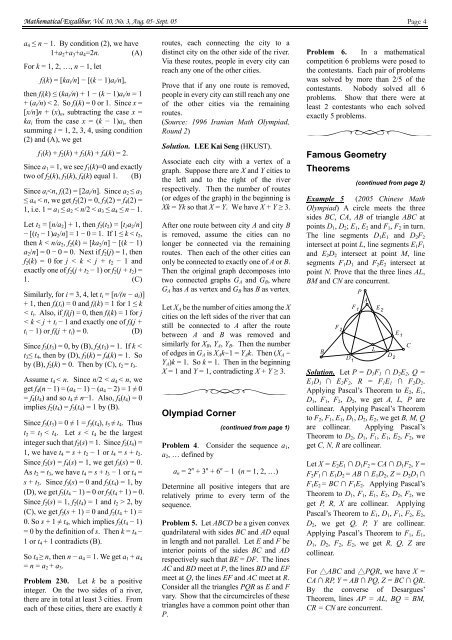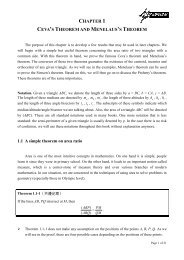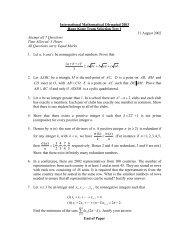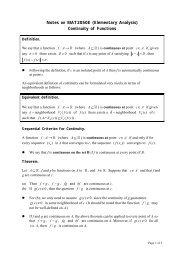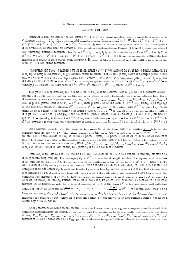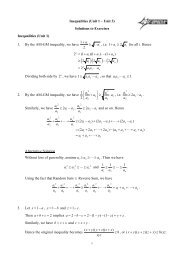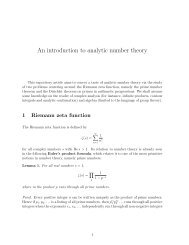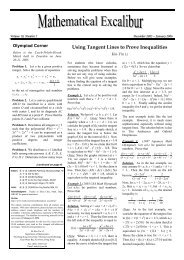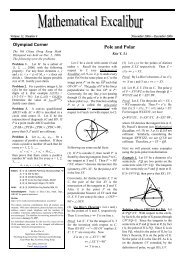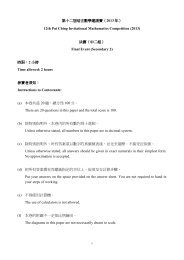Famous Geometry Theorems - Department of Mathematics - The ...
Famous Geometry Theorems - Department of Mathematics - The ...
Famous Geometry Theorems - Department of Mathematics - The ...
You also want an ePaper? Increase the reach of your titles
YUMPU automatically turns print PDFs into web optimized ePapers that Google loves.
Mathematical Excalibur, Vol. 10, No. 3, Aug. 05- Sept. 05 Page 4<br />
a 4 ≤ n − 1. By condition (2), we have<br />
1+a 2 +a 3 +a 4 =2n. (A)<br />
For k = 1, 2, …, n − 1, let<br />
f i (k) = [ka i /n] − [(k − 1)a i /n],<br />
then f i (k) ≤ (ka i /n) + 1 − (k − 1)a i /n = 1<br />
+ (a i /n) < 2. So f i (k) = 0 or 1. Since x =<br />
[x/n]n + (x) n , subtracting the case x =<br />
ka i from the case x = (k − 1)a i , then<br />
summing i = 1, 2, 3, 4, using condition<br />
(2) and (A), we get<br />
f 1 (k) + f 2 (k) + f 3 (k) + f 4 (k) = 2.<br />
Since a 1 = 1, we see f 1 (k)=0 and exactly<br />
two <strong>of</strong> f 2 (k), f 3 (k), f 4 (k) equal 1. (B)<br />
Since a i 2, by<br />
(C), we get f 2 (s + 1) = 0 and f 2 (t 4 + 1) =<br />
0. So s + 1 ≠ t 4 , which implies f 2 (t 4 − 1)<br />
= 0 by the definition <strong>of</strong> s. <strong>The</strong>n k = t 4 −<br />
1 or t 4 + 1 contradicts (B).<br />
So t 4 ≥ n, then n − a 4 = 1. We get a 1 + a 4<br />
= n = a 2 + a 3 .<br />
Problem 230. Let k be a positive<br />
integer. On the two sides <strong>of</strong> a river,<br />
there are in total at least 3 cities. From<br />
each <strong>of</strong> these cities, there are exactly k<br />
routes, each connecting the city to a<br />
distinct city on the other side <strong>of</strong> the river.<br />
Via these routes, people in every city can<br />
reach any one <strong>of</strong> the other cities.<br />
Prove that if any one route is removed,<br />
people in every city can still reach any one<br />
<strong>of</strong> the other cities via the remaining<br />
routes.<br />
(Source: 1996 Iranian Math Olympiad,<br />
Round 2)<br />
Solution. LEE Kai Seng (HKUST).<br />
Associate each city with a vertex <strong>of</strong> a<br />
graph. Suppose there are X and Y cities to<br />
the left and to the right <strong>of</strong> the river<br />
respectively. <strong>The</strong>n the number <strong>of</strong> routes<br />
(or edges <strong>of</strong> the graph) in the beginning is<br />
Xk = Yk so that X = Y. We have X + Y ≥ 3.<br />
After one route between city A and city B<br />
is removed, assume the cities can no<br />
longer be connected via the remaining<br />
routes. <strong>The</strong>n each <strong>of</strong> the other cities can<br />
only be connected to exactly one <strong>of</strong> A or B.<br />
<strong>The</strong>n the original graph decomposes into<br />
two connected graphs G A and G B , where<br />
G A has A as vertex and G B has B as vertex .<br />
Let X A be the number <strong>of</strong> cities among the X<br />
cities on the left sides <strong>of</strong> the river that can<br />
still be connected to A after the route<br />
between A and B was removed and<br />
similarly for X B , Y A , Y B . <strong>The</strong>n the number<br />
<strong>of</strong> edges in G A is X A k-1 = Y A k. <strong>The</strong>n (X A -<br />
Y A )k = 1. So k = 1. <strong>The</strong>n in the beginning<br />
X = 1 and Y = 1, contradicting X + Y ≥ 3.<br />
Olympiad Corner<br />
(continued from page 1)<br />
Problem 4. Consider the sequence a 1 ,<br />
a 2 , … defined by<br />
a n = 2 n + 3 n + 6 n − 1 (n = 1, 2, …)<br />
Determine all positive integers that are<br />
relatively prime to every term <strong>of</strong> the<br />
sequence.<br />
Problem 5. Let ABCD be a given convex<br />
quadrilateral with sides BC and AD equal<br />
in length and not parallel. Let E and F be<br />
interior points <strong>of</strong> the sides BC and AD<br />
respectively such that BE = DF. <strong>The</strong> lines<br />
AC and BD meet at P, the lines BD and EF<br />
meet at Q, the lines EF and AC meet at R.<br />
Consider all the triangles PQR as E and F<br />
vary. Show that the circumcircles <strong>of</strong> these<br />
triangles have a common point other than<br />
P.<br />
Problem 6. In a mathematical<br />
competition 6 problems were posed to<br />
the contestants. Each pair <strong>of</strong> problems<br />
was solved by more than 2/5 <strong>of</strong> the<br />
contestants. Nobody solved all 6<br />
problems. Show that there were at<br />
least 2 contestants who each solved<br />
exactly 5 problems.<br />
<strong>Famous</strong> <strong>Geometry</strong><br />
<strong><strong>The</strong>orems</strong><br />
(continued from page 2)<br />
Example 5 (2005 Chinese Math<br />
Olympiad) A circle meets the three<br />
sides BC, CA, AB <strong>of</strong> triangle ABC at<br />
points D 1 , D 2 ; E 1 , E 2 and F 1 , F 2 in turn.<br />
<strong>The</strong> line segments D 1 E 1 and D 2 F 2<br />
intersect at point L, line segments E 1 F 1<br />
and E 2 D 2 intersect at point M, line<br />
segments F 1 D 1 and F 2 E 2 intersect at<br />
point N. Prove that the three lines AL,<br />
BM and CN are concurrent.<br />
B<br />
P<br />
A<br />
F 1 E 2<br />
F 2<br />
D 1<br />
D 2<br />
E 1<br />
Solution. Let P = D 1 F 1 ∩ D 2 E 2 , Q =<br />
E 1 D 1 ∩ E 2 F 2 , R = F 1 E 1 ∩ F 2 D 2 .<br />
Applying Pascal’s <strong>The</strong>orem to E 2 , E 1 ,<br />
D 1 , F 1 , F 2 , D 2 , we get A, L, P are<br />
collinear. Applying Pascal’s <strong>The</strong>orem<br />
to F 2 , F 1 , E 1 , D 1 , D 2 , E 2 , we get B, M, Q<br />
are collinear. Applying Pascal’s<br />
<strong>The</strong>orem to D 2 , D 1 , F 1 , E 1 , E 2 , F 2 , we<br />
get C, N, R are collinear.<br />
Let X = E 2 E 1 ∩ D 1 F 2 = CA ∩ D 1 F 2 , Y =<br />
F 2 F 1 ∩ E 1 D 2 = AB ∩ E 1 D 2 , Z = D 2 D 1 ∩<br />
F 1 E 2 = BC ∩ F 1 E 2 . Applying Pascal’s<br />
<strong>The</strong>orem to D 1 , F 1 , E 1 , E 2 , D 2 , F 2 , we<br />
get P, R, X are collinear. Applying<br />
Pascal’s <strong>The</strong>orem to E 1 , D 1 , F 1 , F 2 , E 2 ,<br />
D 2 , we get Q, P, Y are collinear.<br />
Applying Pascal’s <strong>The</strong>orem to F 1 , E 1 ,<br />
D 1 , D 2 , F 2 , E 2 , we get R, Q, Z are<br />
collinear.<br />
For △ABC and △PQR, we have X =<br />
CA ∩ RP, Y = AB ∩ PQ, Z = BC ∩ QR.<br />
By the converse <strong>of</strong> Desargues’<br />
<strong>The</strong>orem, lines AP = AL, BQ = BM,<br />
CR = CN are concurrent.<br />
L<br />
C


